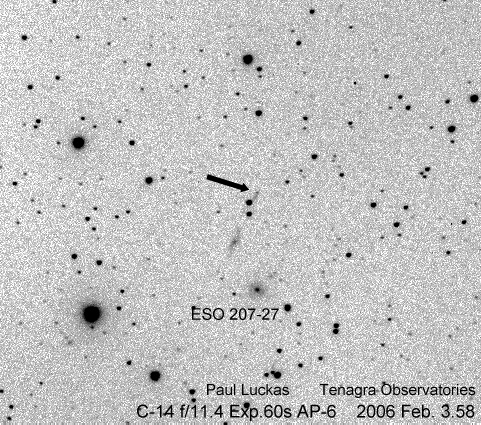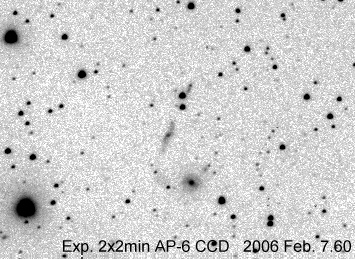Home
Supernova 2006Y in anonymous galaxy near ESO 207-G26

|
Anonymous galaxy in Carina
Dist. ?? million l.y. (?)
Supernova Mag 17.7:CR
Date : Feb. 3.58 2006
Exposure time : 60 sec.
0.35m f/11.4 AP-6 CCD
|

|
Supernova Mag 17.3CR
Date : Feb. 7.60 2006
|
Photometry reference image.
IAU Circulars & Type determination for SN 2006Y
Circular No. 8668
Central Bureau for Astronomical Telegrams
INTERNATIONAL ASTRONOMICAL UNION
Mailstop 18, Smithsonian Astrophysical Observatory, Cambridge, MA 02138, U.S.A.
IAUSUBS@CFA.HARVARD.EDU or FAX 617-495-7231 (subscriptions)
CBAT@CFA.HARVARD.EDU (science)
URL http://cfa-www.harvard.edu/iau/cbat.html ISSN 0081-0304
Phone 617-495-7440/7244/7444 (for emergency use only)
SUPERNOVAE 2006Y AND 2006Z
Two apparent supernovae have been reported: 2006Y by P.
Luckas, O. Trondal, and M. Schwartz (cf. IAUC 8655; unfiltered CCD
frames, 0.35-m Tenagra telescope at Perth) and 2006Z by the SDSS
collaboration (found in spectra; communicated by M. SubbaRao,
University of Chicago and Adler Planetarium; cf. IAUC 8513; r-band
magnitude given below).
SN 2006 UT R.A. (2000.0) Decl. Mag. Offset
2006Y Feb. 3.58 7 13 17.19 -51 41 18.8 17.7 1".7 W, 5".2 N
2006Z Feb. 1.51 13 44 58.07 +26 18 25.7 20.4 --
Additional unfiltered magnitudes of 2006Y: Jan. 27.59 UT, [18.5;
Feb. 7.60, 17.3. SN 2006Z, which appears to be a type-Ia supernova
with an age of approximately -7 +/- 4 days after maximum light, is
coincident with the center of the host galaxy (r = 17.0 from an
image taken on 2004 June 12; z = 0.1232).
(C) Copyright 2006 CBAT
2006 February 8 (8668) Daniel W. E. Green
Electronic Telegram No. 422
Central Bureau for Astronomical Telegrams
INTERNATIONAL ASTRONOMICAL UNION
M.S. 18, Smithsonian Astrophysical Observatory, Cambridge, MA 02138,
U.S.A.
IAUSUBS@CFA.HARVARD.EDU or FAX 617-495-7231 (subscriptions)
CBAT@CFA.HARVARD.EDU (science)
URL http://cfa-www.harvard.edu/iau/cbat.html
SUPERNOVAE 2006Y AND 2006ai
N. Morrell and G. Folatelli, on behalf of the Carnegie Supernova
Project, report that spectroscopy (range 380-930 nm) of SN 2006Y (cf.
IAUC 8668), obtained on Feb. 27.14 UT with the Las Campanas 2.5-m du
Pont telescope (+ WFCCD spectrograph), showing it to be a type-II
event, nearly one month after explosion. A spectrum of the apparent
nucleus of the host galaxy was also obtained, from which is derived a
recession velocity of 10074 km/s (redshift 0.0336 +/- 0.0001). From
nebular emission lines superimposed on the supernova spectrum, a
slightly different redshift of 0.0333 +/- 0.0001 is derived; using
this value, an expansion velocity of 7650 km/s for this supernova is
derived from the minimum of the H_beta absorption. A redshift of
0.0341 +/- 0.0002 was also measured for ESO 207-G27 (a galaxy located
southeast of the supernova host).
A spectrum of SN 2006ai (cf. IAUC 8674), obtained on Mar. 5.12 with
the same instrumental configuration, shows it to be a type-II supernova,
at least one month after explosion, for which an expansion velocity of
8050 km/s is derived from the minimum of the H_beta absorption,
considering a redshift of 7426 km/s (z = 0.0158 +/- 0.0001) measured
from emission lines in the spectrum of the host galaxy.
NOTE: These 'Central Bureau Electronic Telegrams' are sometimes
superseded by text appearing later in the printed IAU Circulars.
(C) Copyright 2006 CBAT
2006 March 7 (CBET 422) Daniel W. E.Green
And here is our report :
SUPERNOVA 2006Y IN ANONYMOUS GALAXY
P. Luckas, Perth, W. Australia; O. Trondal, Oslo, Norway; and M.Schwartz, Patagonia,
AZ, report the discovery of an apparent supernova in an anonymous galaxy
on unfiltered CCD frames taken with a 0.35-m Tenagra telescope at
Perth on 2006 Feb. 3.58 (at mag 17.7) and Feb. 7.60 UT (mag 17.3) in
the course of the Tenagra Observatory Supernova Search.
SN 2006Y is
located at R.A. = 7h13m17s.19, Decl. = -51o41'18".8 (equinox
2000.0), which is 1".7 west and 5".2 north of the center of the anonymous
galaxy (which itself has position R.A. = 7h13m17s.37, Decl. = -51o41'24".0
(equinox 2000.0)).
Nothing was visible at the position of 2006Y on an image taken by
Luckas on 2006 Jan. 27.59 (limiting magnitude about 18.5).

